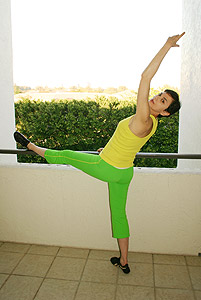 Loading... Please wait...
Loading... Please wait...- Home
- COACH
- SHOP
- JOIN CLUB
- ART
- FABULOSITY®
- BIO
- CONSULT
- AMAZON
- Reviews
-
Live Long
- Diet & Nutrition
- Easy Exercise Videos Mirabai Holland
- Fitness Longevity
- Fabulous Forever After 50 Mirabai Holland
- Senior Exercise Videos Mirabai Holland
- Baby Boomer Exercise Mirabai Holland
- Beginner Exercise Videos Mirabai Holland
- Moving Free
- Weight Loss
- Cardio
- Strength
- Flexibility
- Body Type
- Stress Reduction
- Medical Care
-
Health
- Exercise and Memory Issues
- Chronic Stress: How To Get Rid Of It
- Exercise & Heart Disease
- Exercise & Diabetes
- Exercise & Autoimmune Diseases
- Osteoporosis
- Exercise for Arthritis
- Back Pain
- Exercise & Orthopedic Issues
- Coping With Cancer
- Pulmonary Asthma
- Exercise And Parkinson's Disease
- Perimenopause & Menopause
- Exercise & Depression
- Sleep Better with Exercise
- BLOG
- Contact
Categories
Our Newsletter
Flexibility

A flexibility program is a series of exercises which combine both static and dynamic movements tapes and DVDs are designed to increase the range of movement about a joint. Staying flexible as we age is a major factor remaining mobile and active into our senior years. Therefore, a good flexibility program is an
essential part of the Longevity Solution™.
Mirabai Holland’s Fabulous Forever® Easy Stretch and Stress Reduction & Moving Free® Flexibility are designed to provide all the flexibility essentials. Here are some Flexibility/Stretch videos to help keep you mobile. Click the individual pictures to learn about each.
Two types of flexibility.
Static Flexibility: Range of movement around a joint in a held position (Example: split)
Dynamic Flexibility: the ability to use a range of movement around the joint while moving (Example: a split leap in the air)
The Stretch Reflex
You start to do a straddle stretch sitting with your legs apart in a v-shape and everyone goes “ooh.”  That ooh is your response to your muscle spindles which are the part of your muscles that don’t contract but sense what your muscle is doing and report back to your brain. Spindles are sending a message to your brain; “Better take the tension off the muscle or someone is going to get hurt.” That is when the stretch reflex kicks in. Anytime the muscle fibers are stretched too far or bouncing up and down (ballistic stretching) they are protected by the tightening of the very muscles you are trying to stretch. However, if the stretch is held long enough in a static position of the GTOs (Golgi Tendon Organs) kick in. They are sensors which sense the tension on tendons and are found on tendons where muscles attach to bones. They say “Hey this is a-okay” and allow the muscles to relax and actually stretch further. So static stretching is better than ballistic stretching because it allows enough time for the GTOs to kick in.
That ooh is your response to your muscle spindles which are the part of your muscles that don’t contract but sense what your muscle is doing and report back to your brain. Spindles are sending a message to your brain; “Better take the tension off the muscle or someone is going to get hurt.” That is when the stretch reflex kicks in. Anytime the muscle fibers are stretched too far or bouncing up and down (ballistic stretching) they are protected by the tightening of the very muscles you are trying to stretch. However, if the stretch is held long enough in a static position of the GTOs (Golgi Tendon Organs) kick in. They are sensors which sense the tension on tendons and are found on tendons where muscles attach to bones. They say “Hey this is a-okay” and allow the muscles to relax and actually stretch further. So static stretching is better than ballistic stretching because it allows enough time for the GTOs to kick in.
 DO’s & DON’TS
DO’s & DON’TS
DO
When stretching, use the "reach-and-hold" technique, or slow dynamic movement, instead of bouncing or pulsing.
DO
Practice proper posture & alignment.
DO
When stretching leg muscles in a standing or sitting position (hamstrings, adductors, rotators of hip) keep spine extended and pivot from the hip; do not round back.
DO
Flexibility exercises as you age
Because of increased degree of dehydration and increased amount of calcium deposits, muscle fibers are replaced with more fatty and fibrous fibers causing an actual chemical change structure of the tissues. Modifications to accomomodate these changes as you age can include: longer warm-up, less stress on back & knees, prone or seated position, emphasize slow dynamic movement
DON’T
Ballistic Stretching
Bouncing up and down (ballistic stretching) to try to stretch farther, strains the muscles and can cause pain, as well as physical damage from microscopic tearing of muscle fibers. Such tearing leads to the formation of scar tissue in the muscles and a gradual loss of elasticity. The muscles become tight and sore.
DON’T
Hamstring/back of knee
Standing toe touch: Puts pressure on lower back area and knees tend to hyperextend. Better alternative is to lie down on the floor with one knee bent and other extended towards the ceiling.
DON’T
Quadriceps
Hurdler's Stretch: The medial ligament of the knee tends to get over-stretched which causes knee instability. A better alternative is to lie on your side or stomach and bring your heel towards your buttocks keeping your abdominals contracted so as not to arch the back.



